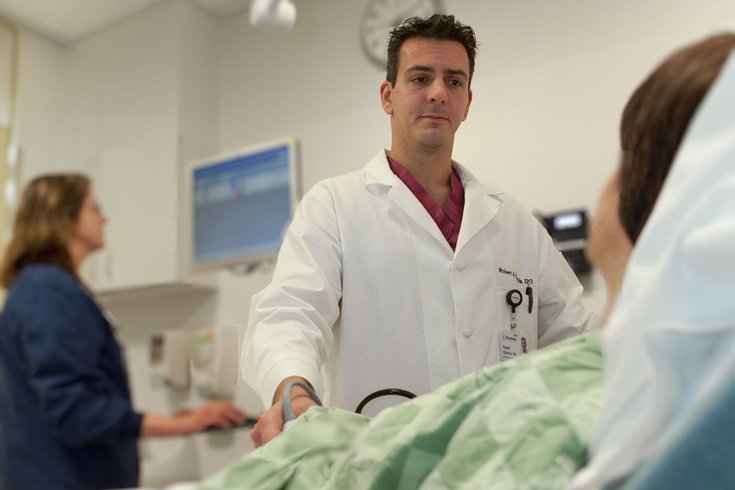
January 08, 2015
 Einstein Medical Center Montgomery/Einstein Medical Center Montgomery
Einstein Medical Center Montgomery/Einstein Medical Center Montgomery
Doctor Robert Czincila in the Emergency Department at Einstein Medical Center Montgomery.
Parents are always warning their smartphone-obsessed teens: Don’t text and drive.
But parents may soon have to heed a warning of their own: Don’t text, tweet, email or consume media on your phone, while looking after your children.
A preliminary study by a Yale economist has linked the rise of smartphone use and lightening-fast network speeds to a sharp uptick in injuries to children under 5.
Related story: The Screening of America: attachment and addiction in our digital age
For years, the number of nonfatal, unintentional injuries to children under 5 had been steadily decreasing thanks to improvements in child safety measures. But from 2005 to 2012, according to the Centers for Disease Control and Prevention, that number has increased 10 percent. The results of the study — still in a working-paper stage — have found a causal link between this increase and the spread of 3G networks across the country.
“What we model for our children is that the phone is more important than they are,” said Temple University psychologist Kathy Hirsh-Pasek. “It's like brain candy.”
Philadelphia parents, caregivers and doctors are seeing the same thing: The rise of smartphone-distracted parents.
“[Smartphones] are a good thing in the sense that caretakers can take pictures of children and send them to their parents,” said Laura Sgroi, 62, as she and her husband watched their grandchildren in tree-lined Rittenhouse Square. “But on the other hand, they can be very distracting.”
“It's something that she and I have noticed a lot more, and not just in Philadelphia,” 63-year-old Rich Sgroi said. “In New York City, we saw the same thing.”
Anna Obendorfer, 22, juggled two energetic children as they weaved through Fitler Square's bronze turtle sculptures. As a nanny, she agrees that devices have become a parenting problem: “I see more parents on their phones, and it's harmful in a way — that they aren't paying attention to their kids.”
In 2012, a Wall Street Journal article titled “The Perils of Texting While Parenting” linked the increase in child injuries with the now-rampant mobile device use by supervising adults. Doctors interviewed in the story highlighted the possible association between the two — but stopped short of pointing the finger at smartphones being a definite cause.
“They pointed out this correlation, but that was about as far as they went,” said study author and Yale graduate student Craig Palsson. “There was no evidence that it could be a causal effect.”
As an economist with the tools to take that extra statistical step, Palsson saw this as a challenge. Are devices really to blame or are children just playing rougher these days?
“When I read that article, my son was 9 months old,” said Palsson, a parent of two with another on the way. “I would take him to the playground, check my phone, and at that moment my son would fall — nothing serious, but still.”
For two years, he tackled the problem as a passion project — a far cry from his day-to-day research, on the economics of developing countries.
He matched city-specific 3G network rollout data with rates of consumer product-related child injury from hospitals tracked by the National Electronic Injury Surveillance System (NEISS). The NEISS uses emergency department data from a nationally representative sample of hospitals.
The release of Apple's iPhone 3G in 2008 was a marked improvement over the original iPhone, including the ability to access a network twice as fast as the previous one. However, the 3G network wasn’t yet available to residents in all cities — it was a gradual rollout process by AT&T, the only iPhone-compatible network at the time. This allowed Palsson to compare cities with a 3G network to those without.
Say City A gets a shiny new 3G network, while City B doesn't. If more injuries happen to children in City A, but not City B, then there's a possibility that the arrival of 3G could have caused the increase. He also compared the number of injuries in City A before versus after the network rollout.
His results strongly indicate that hospitals experienced a rise in all child injuries after AT&T expanded its 3G network into the area, with the greatest impact showing up among kids younger than 5 — those who would be most in need of supervision — hinting that caregiver distraction could be involved.
Next, Palsson wanted to find out if distracted caregivers were driving these new injuries. To do this, he looked at locations where direct caregiver supervision is required, such as public playgrounds, public pools or at home. These areas saw a significant uptick in injuries after the rollout of a 3G network. On the other hand, when teachers or coaches take the supervising reins from parents -- during sports activities or at school -- there was no increase.
“What we model for our children is that the phone is more important than they are,” said Temple University psychologist Kathy Hirsh-Pasek. “It's like brain candy.”
Hirsh-Pasek worries that children of distracted parents aren't learning as much during a crucial time when their brains are primed to soak up new information. One of her graduate students recently conducted a study in which adults taught young children a new word. In one trial, adults were interrupted during the lesson; in the other, they were able to give full attention to the children.
“The children didn't learn the new word in the interrupted condition, but they did learn it in the uninterrupted condition,” she said. “The bottom line is that we believe we are outstanding multitaskers, but the truth is only 2 percent of the population is.”
In a series of studies, psychologist David Strayer discovered that roughly 98 percent of people can’t do two things at once — like talking on a cell phone and driving a car — without showing a deterioration in performance. Brake reaction times get delayed, and obvious changes in traffic signals are missed. Aside from the 2 percent of so-called “supertaskers,” multitasking hinders our ability to do either task well.
At the Markward Playground, first-time-dad Christopher McManus, 36, expressed concern about his son developing bad habits — mainly a dependence on technology — even before knowing what a smartphone is.
“He knows that the phone is like a magic portal to somewhere else, and he carries his little music device around in the same way,” said McManus, who tries to minimize both his and his son's screen time. “I'm concerned about the development of proper motor skills and imagination.”
Although Philadelphia-specific data could not be elaborated by Palsson due to hospital privacy issues, emergency medicine physician Robert Czincila of Einstein Medical Center Montgomery believes device-distracted parenting may indeed be responsible for some portion of injuries in children under 5 years old.
“There's certainly an uptick of injuries in that age group, and it seems unusual since in the late '70s, safety became a more prominent issue with car seats, helmets and better cribs,” Czincila said. “But in the past few years, the numbers are increasing.”
However, he is quick to note that parents bringing their children to the hospital are naturally hesitant to admit they were playing Candy Crush on their phone instead of playing with their child. Also, he is seeing more children trying athletic activities like snowboarding, motorized scooters, and trampolines at a younger age — another possible contributor to the rise in injuries.
“Kids are very mobile at that age and tend to get into everything,” Czincila said. “We see kids with burns, falls, ingestions — all it takes is a few minutes of not paying attention, and something bad can happen.”
Meeri Kim, Ph.D., is a science journalist who contributes regularly to the Washington Post and Philadelphia Inquirer. She has been a Philadelphia resident since 2005, and received her doctorate in physics from the University of Pennsylvania last year. You can follow her on Twitter: @meeri_kim